Productivity begins with your calendar—but it can also come to a halt there. Nobody wants to reshuffle an entire week due to an emergency or play calendar Tetris to secure a meeting with a busy lead in the next couple of days. This is where an AI scheduling assistant comes in handy: instead of managing your schedule yourself, you can let AI calendar apps handle it for you.
Concentrate on the meeting, not the scheduling
Automate your bookings
Recently, we have been exploring a range of AI tools. For this article, we examined several dozen AI calendars and carried out extensive research and testing to pinpoint the top AI scheduling assistants that can manage the more intricate aspects for you.
Top 8 best AI scheduling assistants
-
Clockwise for syncing team calendars
-
Motion for AI-assisted project management
-
Kronologic for following up with more leads
Which is Right for You? Smart or AI Powered Calendars
When it comes to managing your schedule, understanding the differences between smart calendars and AI calendars is crucial. Smart calendars rely on deterministic algorithms, which follow fixed rules set by developers to optimize your schedule. These rules ensure consistent results for similar inputs, such as scheduling a daily task like "jogging" at the same time every day.
On the other hand, AI calendars offer a more advanced and dynamic approach. They can identify patterns, make decisions, and learn from past experiences. As AI calendars process your data, they adapt and make increasingly relevant adjustments. For example, they can determine how long you typically take to complete a task and adjust future estimates accordingly. They can also identify your peak productivity times and prioritize tasks during those periods, providing a personalized scheduling experience.
Choosing between a smart calendar and an AI calendar depends on your specific needs. If you prefer a straightforward, rule-based system, a smart calendar might be sufficient. However, if you want a more adaptive and personalized scheduling tool, an AI calendar is the way to go.
AI Scheduling Tools: What You Should Look For
Our Evaluation and Testing Process for Scheduling Apps
At AI Free Lifer, our app reviews are conducted by experts with years of experience in testing, and using, all types of software. We meticulously evaluate each app based on specific criteria tailored to the category. Our process involves hours of research and testing, ensuring that every app is used as it’s intended.
For full transparency: some of the apps we feature may provide us with a commission if you make a purchase through one of the links on our site. However, this has no influence on how we rate the apps or which apps we choose to feature. Our recommendations are always based on genuine evaluations of the apps’ performance and value.
If you're curious about how we select the apps for our reviews, check out our full review process on the blog.
Key Features to Consider in an AI Scheduling Assistant
Are you ready to embrace the future with AI-powered scheduling tools? Here are the key features we focused on while testing each AI scheduling app:
1. User-Friendly Interface
The interface should allow you to quickly access your calendar, add or modify events, and integrate with other tools you use regularly, such as email or project management apps. Additionally, responsive design is crucial so that the assistant works seamlessly across different devices, whether you're on a desktop, tablet, or smartphone. The goal is to create a user experience that feels natural and supportive, enabling you to focus on your work rather than wrestling with the software.
2. Easy Setup and Smooth Integrations
Setting up your AI scheduler should take less than five minutes. It should be easy to connect your favorite calendar. We also picked apps that work well with popular tools like Zoom or Slack to make meeting links and teamwork smoother. Saving time here means you have more time for other things!
3. True AI Features
We made sure these apps use real AI, not just "smart" gimmicks. If the AI features were confusing, we called customer support to understand the technology and confirm how the scheduling works.
4. Insights and Learning Resources
Every top-tier AI scheduling app offers helpful resources such as tooltips, articles, or video tutorials. These ensure users can easily understand how their calendar is being optimized or reorganized by AI.
5. Innovative Extras
We looked for special AI features that can really transform how you handle your schedule. From automatic time-blocking for focused work to advanced meeting coordination, the top apps provide tools that go way beyond basic scheduling.
How We Test
Our team signed up for each AI scheduling tool and added our real schedules. Then, we made different changes to see how each tool handled them. This included setting up many meetings (sometimes with ourselves using different calendar accounts), moving events around, and watching how the AI performed over a week. We carefully tested all the settings, tried every feature, and checked how well the AI responded to different inputs.
After thorough research and testing, we found the best AI scheduling apps that truly save time, keep your calendar organized, and are easy to use.
A quick overview of the top AI scheduling assistants
|
AI Apps |
Best for |
Standout feature |
Pricing |
|---|---|---|---|
|
Reclaim |
Protecting your habits |
Manages recurring events well |
Free plan available for 2 calendars, 3 habits, and limited integrations; paid plans start at $8/user/month |
|
Clockwise |
Syncing team calendars |
Thorough onboarding experience |
Free plan available for basic features; paid plans start at $6.75/user/month |
|
Motion |
AI-assisted project management |
High visibility for tasks |
Individual plan for $34/month; Team plan for $20/user/month |
|
SkedPal |
Time-blocking |
Time budgeting feature |
From $14.95/month |
|
Katch |
An AI virtual assistant |
Most of the scheduling is managed directly through your inbox |
From $1.99/month |
|
Trevor |
Simple, free AI solution for task management |
Intuitive, simple controls to schedule and manage tasks |
Free plan available; paid plan is $3.99/month |
|
Kronologic |
Following up with more leads |
Caters to sales teams but can also replace Calendly |
Plans start at $6/month |
|
Scheduler AI |
Managing meetings for busy teams |
Works well for all kinds of meetings |
Plans start at $50/user/month |
Best AI scheduler for protecting your habits
Reclaim (Web)
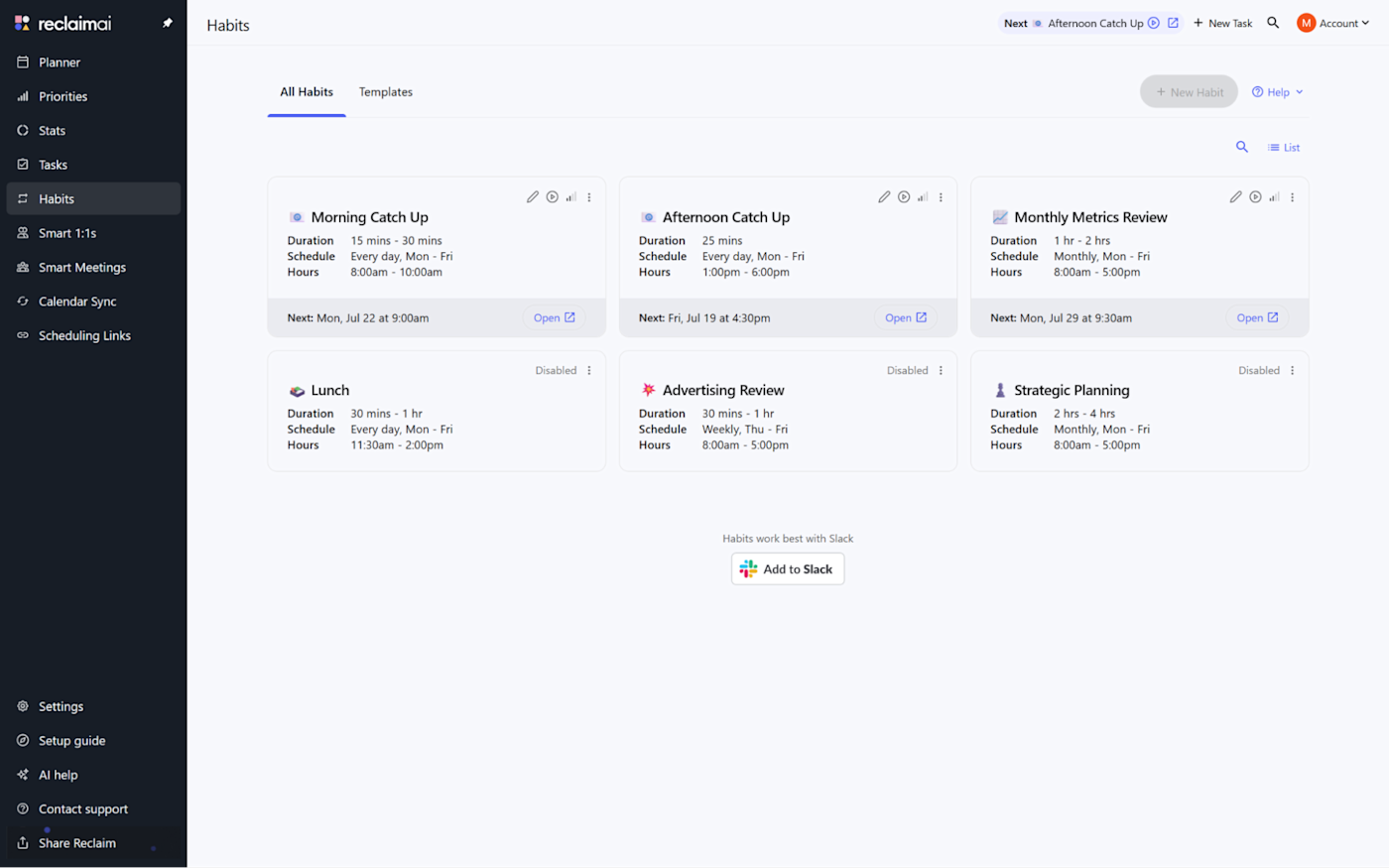
Reclaim pros:
-
Effectively handles recurring events
-
Swiftly rearrange and modify your calendar upon detecting a conflict
Reclaim cons:
-
Native task management is clunky
Building consistent habits is crucial, and Reclaim.ai excels as an AI calendar assistant to help you achieve that. It not only looks appealing but also performs exceptionally well, striking the perfect balance between power and simplicity.
During the onboarding process, you define your work hours, incorporate your habits, and set the AI engine's priorities for your tasks. The app clearly explains its operations, ensuring you won't wake up to a drastically altered calendar and wonder what happened (a common issue with many other apps I tested).
The main action takes place on the Planner screen, featuring a central calendar view flanked by three lists: priority habits, open tasks, and low-priority habits. This layout allows you to easily monitor your remaining tasks, helping you stay focused.
I particularly appreciated the customization options for each habit: besides setting start and end times, you can choose an ideal time and determine how strictly the AI should reschedule. If set to Always free, it will easily accommodate interruptions; if set to Busy, it won't allow even the most important meetings to interfere.
You can manually enter all your tasks, and Reclaim will automatically schedule them. Even better, you can integrate various task management apps and enable sync, automating the entire process. As it schedules your upcoming tasks, it will safeguard the time needed for critical tasks against unexpected 1:1 meetings. For weekly catch-ups, Reclaim can reschedule recurring meetings if someone cancels, finding the optimal time slot and sending the necessary notifications.
If you're struggling to maintain your morning meditation or afternoon walk, Reclaim will help you stay on track without the hassle of scheduling.
Reclaim.ai pricing: Free plan available for 2 calendars, 3 habits, and limited integrations and features; paid plans start at $8/user/month for unlimited calendars, unlimited habits, more integrations, and advanced features.
Best scheduling AI tool for syncing team calendars
Clockwise (Web, Chrome, and Firefox extensions)
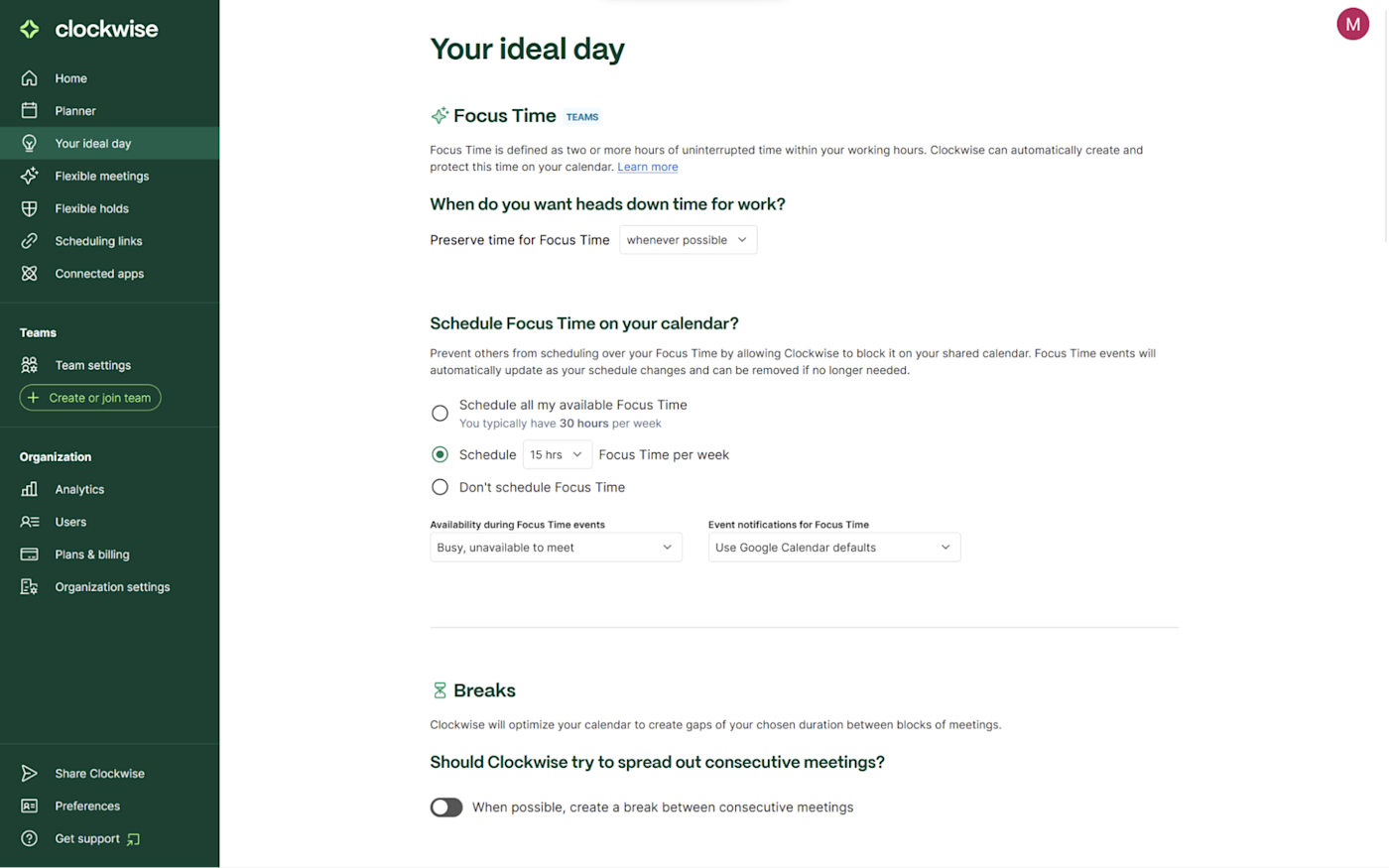
Clockwise pros:
-
Comprehensive onboarding process
-
Extensive in-app guidance and explanations
Clockwise cons:
-
Not compatible with personal Google accounts, only available for Workspace.
Clockwise's #1 objective is to create time for you by putting together more focused blocks, reducing conflicts when scheduling meetings with others, and providing stats to help you see how you're doing.
Clockwise has lots of knobs and levers—it's definitely the most customizable engine on this list. The onboarding experience lets you fine-tune the balance between meetings and focused work. When I finished setting up my account, Clockwise blocked three hours of continuous focus work every day and two hours of fragmented work time. My 45-minute lunch break hovers somewhere between noon and 3 p.m., depending on meetings and deadlines. Where will it land? Who knows. And there's one special treat you get your first week with the app: Clockwise organizes your time better, freeing up a 30-minute break you can use to have a cup of coffee.
If you want to revisit these settings at any time, click Your ideal day on the dashboard, and set everything from when you should have lunch to how much travel time to reserve for a meeting away from the office.
While Clockwise feels strong for a solo player, it's meant for teams. When you connect it to Slack, it updates your status based on what's on your calendar and prevents non-urgent messages from pinging you. And the Asana integration lets you assign tasks to your calendar, so you can go there to fill up your plate and come back to Clockwise to bite it bit by bit.
Unsure if it's actually doing anything for your productivity? Visit the Analytics dashboard, with a count of all schedule assists, meeting conflicts resolved, and a breakdown of focus hours created. If you want to implement a no-meeting day, there's a specific setting you can tick on to try that out.
Clockwise price: Free plan available for basic features; paid plans start at $6.75/user/month for advanced features, team productivity tools, and more security and support.
Best AI schedule assistant for project management
Motion (Web, iOS, Android)

Motion pros:
-
High visibility for tasks
-
Excellent controls for prioritizing tasks
Motion cons:
-
Somewhat complicated
Motion is an AI calendar that seamlessly integrates with a robust project management app. The outcome? An excellent scheduling engine combined with advanced task tracking, ensuring you never miss a deadline.
The user experience is tailored for productivity enthusiasts, keeping all essential information within easy reach. On the left side, you have a list of all your upcoming tasks, which you can scroll through extensively. The main part of the screen features the calendar with day and week views. Need to schedule something quickly? Simply click and drag anywhere on the calendar to slot in that urgent task. If it overlaps with an existing event, Motion will rearrange your to-dos to make everything fit neatly. However, be patient: after making significant changes, you'll need to wait a moment for the engine to sort everything out.
By clicking on the Projects & Tasks tab, you can create your workspace. Once set up, invite your team, add your projects, and start assigning tasks. You can view everything in a list or a Kanban view. Any tasks you add here will automatically appear on your calendar. If you're not a manager, the dashboard will look simpler: click on My Tasks and immerse yourself in deep work.
What stood out to me were the settings available for each task. You can assign four priority levels, from ASAP to Low, which will determine how soon the task appears on your calendar. You can also specify whether the task has a soft or hard deadline, allowing the engine to be more strict or lenient as the date approaches. If you fall behind, the dashboard will display a warning showing the number of tasks at risk of missing their due dates, prompting you to adjust the task details or pick up the pace—whichever makes the most sense.
The project management features go further, including task notes, sub-tasks, task labels, and an activity feed where you can leave comments for your team. Another feature I appreciated was the ability to add project and task templates, which, given the numerous controls available, really helps speed things up.
While Motion advocates for fewer meetings on its marketing pages, it still allows you to create meeting templates and assign a priority for each type of meeting, with more urgent ones having the power to displace other tasks. This makes it a highly comprehensive scheduling assistant.
You can do even more with Motion by connecting it to Zapier. Automatically create new Motion tasks from Slack messages, emails, and any other tool you use at work. Learn more about how to automate Motion.
Motion price: Individual plan for $34/month; Team plan for $20/user/month (with steep discounts for paying annually).
Best AI scheduling assistant for time-blocking
SkedPal (Web, iOS, Android)

SkedPal pros:
-
Great onboarding
-
Easy natural language input
SkedPal cons:
-
Time blocking feature takes some getting used to
Time-blocking involves scheduling tasks so you can effectively accomplish what you need to do. This method offers several benefits: it helps you understand how long each task will take, allows you to group tasks by cognitive intensity or topic, and generally leads to a more organized day. SkedPal is the ideal app to assist you with this.
The app features a comprehensive and interactive onboarding process, enabling you to start using it proficiently in under 20 minutes. It includes a mix of videos and hands-on tutorials to guide you. You can add tasks by specifying their name, duration, and due date in natural language. For instance, if you type "Send outline 5m due Friday," the app will recognize that the task takes five minutes and is due by Friday. Tasks are color-coded by due date, so you can easily see which ones need immediate attention.
The time-blocking feature requires initial setup but becomes easy to use afterward. By clicking on your profile picture and selecting Time Maps, you can create new time-blocking labels and designate specific calendar regions. SkedPal already categorizes your day into segments like Mornings and Evenings, which you can use to allocate tasks.
You can paint calendar slots in different colors: green slots are filled first, yellow next, and red as a last resort. This customization allows you to control how tasks are distributed throughout your day or week. To assign tasks to a time map, simply write the duration and due date in natural language, followed by a forward slash to select the appropriate time map.
For more detailed planning, you can set up time budgets. For example, you might allocate five hours weekly for studying no-code development, whether in one sitting or spread out over several days. SkedPal helps you create and monitor these time budgets, ensuring you don't over-schedule and affect your productivity elsewhere. Time is finite, so it's essential to manage it wisely.
Best AI scheduling tool for having an AI assistant
Katch (Web, WhatsApp, email inbox)

Katch pros:
-
AI interprets intents very well
-
Inexpensive
Katch cons:
-
Only works with Google Calendar
Scheduling links can be problematic: they might reveal your availability, making it seem like you're not that busy, or worse, they could fill your days with unnecessary meetings. Katch eliminates the need for scheduling pages by managing everything directly in your inbox.
Simply create an account, link your calendar, set your availability, and you're set. Most interactions occur as you message people, not on the app's dashboard. When emailing someone, you can CC assistant@gokatch.ai and request a meeting setup. You'll receive a response like this:
Hello Dave,
I've found some potential time slots for your meeting next week.
Monday, July 22nd at 9:30am BST
Monday, July 22nd at 12:00pm BST
Tuesday, July 23rd at 9:30am BST
Please let me know which time works best for you, or if you need more options.
Once the other person confirms their preferred time, Katch handles the meeting invites, including video conferencing links. If you're dealing with a busy lead, the AI can suggest additional times, reschedule, or cancel the meeting as needed. You can also log into the app dashboard to view a timeline of all scheduling attempts, providing insight into the process.
In addition to email, Katch offers a WhatsApp assistant for on-the-go management. You can text or send a voice message to reschedule meetings, move them forward if you're running late, or get a quick overview of your day.
.
Katch price: The Personal plan, at $1.99/month, unlocks all the features, with unlimited assistant requests, scheduling, and WhatsApp.
Top AI calendar for a straightforward, free task management solution
Trevor (Web)
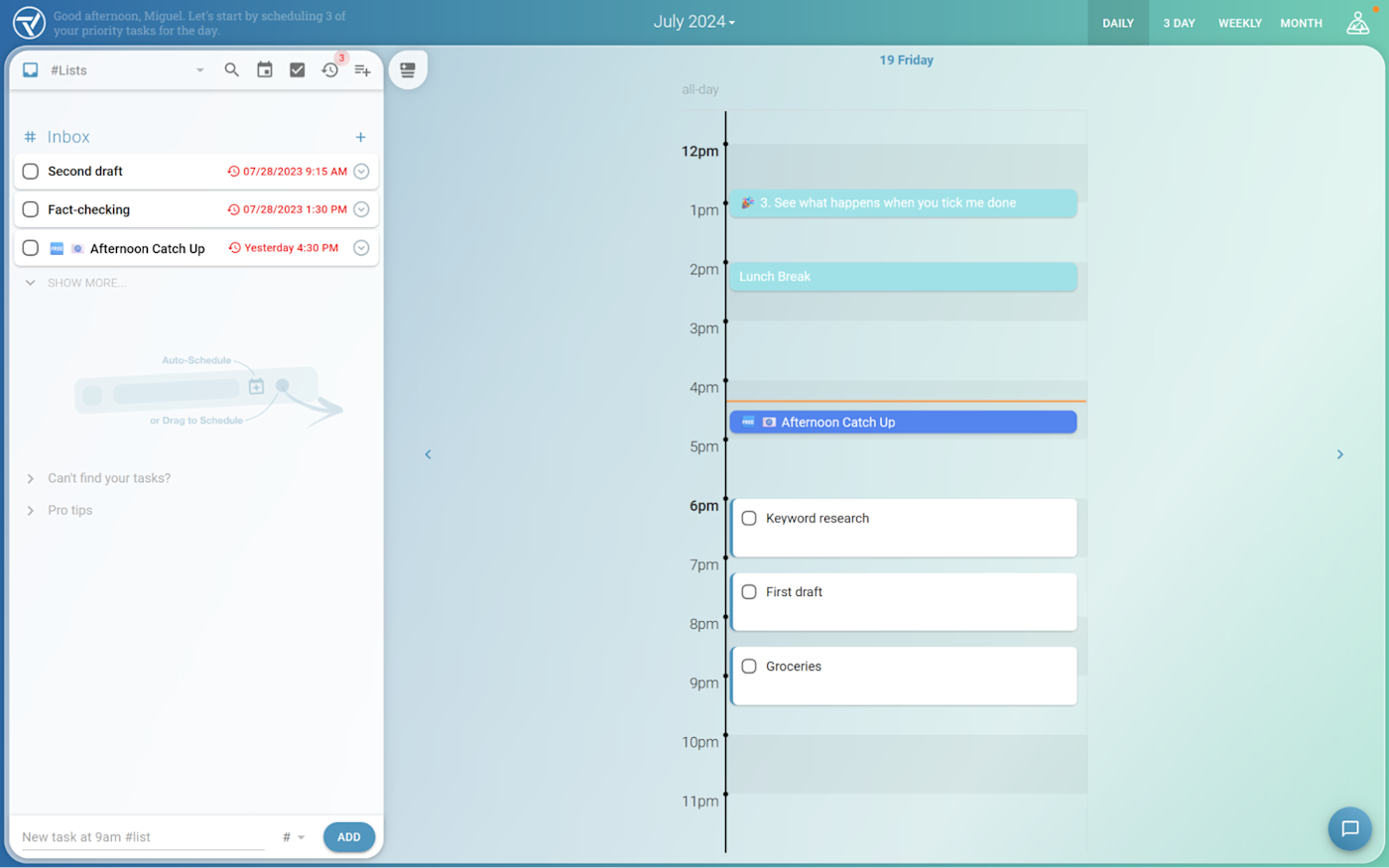
Trevor pros:
-
Very intuitive
-
Simple controls to help you schedule and manage tasks
Trevor cons:
-
Requires a bit too much interaction
Trevor is straightforward. It won't rearrange your entire day for emergencies, and it lacks advanced controls, but it offers a user-friendly experience and AI features that help you place your tasks in the optimal calendar slots.
Begin by connecting your calendar. Trevor will recognize the events you already have scheduled but won't alter them. Instead, it creates a separate calendar for your tasks, which you can toggle on or off within Google Calendar. This way, it won't disrupt your existing events, allowing you to maintain control over your schedule while benefiting from AI assistance.
Next, add your tasks to the list on the left. They are initially categorized with the hashtag #inbox, but you can create other categories via the three-dot menu. Once your tasks are ready, click and drag each one to the calendar. Trevor will recommend the best times to schedule each activity by highlighting the appropriate time slots. It learns from your usage, improving its suggestions over time.
There's a calming experience here, thanks to the soft colors and the process of adding tasks, dragging them to your schedule, and focusing on the day view. After using it for a day, I felt less drained, reaching the end of my day with more energy.
This is my personal take, so give it a try to see if it suits your workflow. The free plan is quite generous, and if you want Trevor to learn faster and be more precise, there's an affordable paid plan. If you appreciate simplicity and immersing yourself in your tasks, Trevor will guide you to deep work without the heavy lifting.
Trevor price: Free plan available; paid plan is $3.99/month.
Top AI scheduling assistant for lead follow-ups
Kronologic (Web)
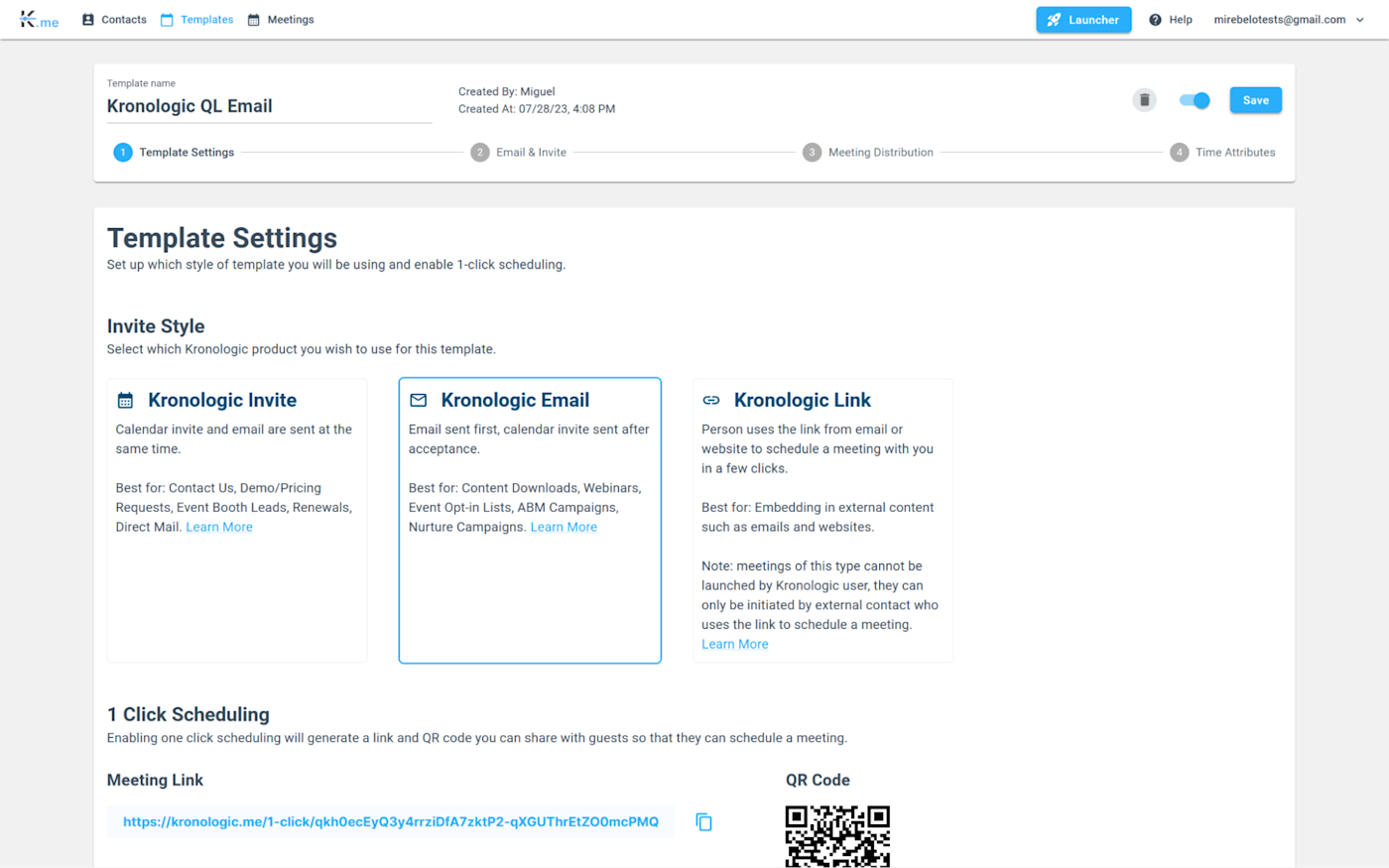
Kronologic pros:
-
Automated meeting scheduling
-
Can replace Calendly
Kronologic cons:
-
Parts of the UI could be better
Kronologic stands out from the other tools on this list. It's specifically designed to help sales teams schedule more calls with interested leads, thereby boosting conversion rates throughout your sales pipeline. To illustrate its capabilities, let me walk you through a few scenarios.
In my experience testing software, most platforms involve self-service registration, leading to a free trial or plan. Occasionally, some apps require filling out a form and waiting for a phone call to schedule a demo. This starts the unpredictable process: Will they call in five minutes? Two days? Will it take one call? Three? It's hard to predict.
After receiving a call from a CRM sales team at 2 a.m. in the chilly British morning, I wished they had used Kronologic. Instead of placing the lead in a queue for a sales rep to pick up whenever they can, the app automatically schedules a date and time when both parties are likely available. If the lead needs to reschedule, Kronologic's natural language processing detects this intent and updates the invite accordingly. Sales team involvement? Minimal to none, if desired.
This is just the beginning of Kronologic's AI capabilities. Imagine you have a list of 200 interested leads. You'd want to schedule calls with them as soon as possible, right? But do you want your sales team scrambling to contact everyone?
Within the app, you can create the meeting type with an email template and set the AI behavior to High-density scheduling. Emails will be sent to these leads, inviting them to a meeting at a specific time and date within a set period. Many of these meetings will overlap, but since the app tracks conversion rates over time, it knows your specific percentage. So, even though you send out 200 invites for 200 meetings in three days, not all leads will be interested, allowing you to identify and engage with those who are.
While Kronologic is ideal for sales teams and larger companies, it now offers pricing tiers and features for individuals and small businesses, along with a Calendly-style scheduling flow if your leads prefer to book a slot in your calendar.
Kronologic price: Subscriptions start at $6 per month.
Top AI scheduling assistant for handling meetings for busy teams
Scheduler AI (Web)
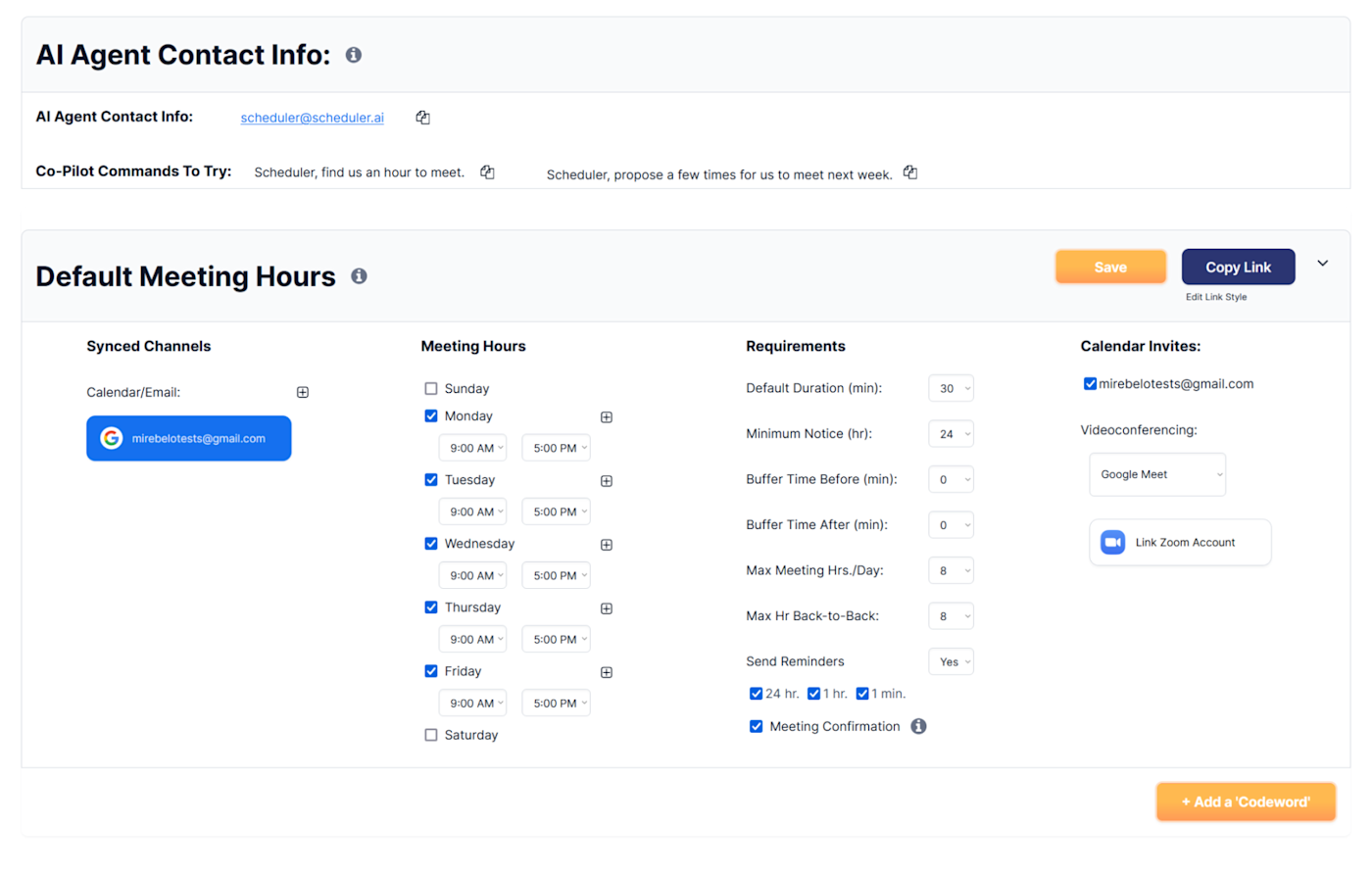
Scheduler AI pros:
-
Great for all kinds of meetings
-
Includes meeting troubleshooting for group meeting scheduling
Scheduler AI cons:
-
Not a lot of controls available on the dashboard yet
Scheduler AI primarily operates through your emails and messages rather than its dashboard. It allows you to schedule 1-on-1s, group meetings, and quickly book demos and discovery calls from your website or landing page. It is effective for both individual use and for scheduling meetings for a sales team, enabling busy organizations to focus on conducting meetings rather than scheduling them.
After setting up your account, keep the scheduler@scheduler.ai email handy for meeting requests. To schedule, simply CC that email and include the phrase: "Scheduler, find us a time next week."
Scheduler will review your calendar and suggest the best available time, pre-reserving the slot until the meeting is confirmed to avoid double-booking. If the other party needs to reschedule, Scheduler manages the email exchanges to find a new time.
For group meetings requiring multiple decision-makers, Scheduler simplifies the process by suggesting times based on your calendar data. If your leads connect their calendars, Scheduler can find the best mutual time. If conflicts arise, it will notify you to manually troubleshoot.
A standout feature is the ability to create meeting types linked to keywords. For instance, if you often have coffee meetings, you can set this up in the dashboard with typical duration and buffer times. Then, during scheduling, just mention "coffee": "Scheduler, find us a time to have coffee next week." You can create multiple meeting types with relevant keywords.
This ability to understand intent and translate it into scheduling actions distinguishes Scheduler AI from its competitors. It integrates with Gmail, Slack, your website, web forms, and even text messages.
Scheduler AI price: Basic plan starts at $50/user/month.
How to find the best AI meeting scheduler
AI calendar management is the future—and I'm not sad about it. As I was researching each AI scheduling app, I started paying attention to how much time I spend on scheduling every day: it added up to about 45 minutes. That's 10% of my day (and maybe yours) spent on scheduling.
If you're in the same boat—or in rougher waters—pick up the AI calendar app that speaks to your pain the most. Try it out for a few weeks and see if it helps you spend your time more productively. I'd be surprised if you didn't notice the difference after even a few days.
Related reading:

